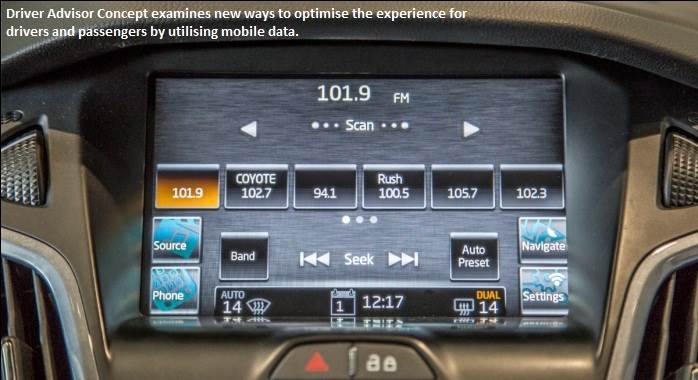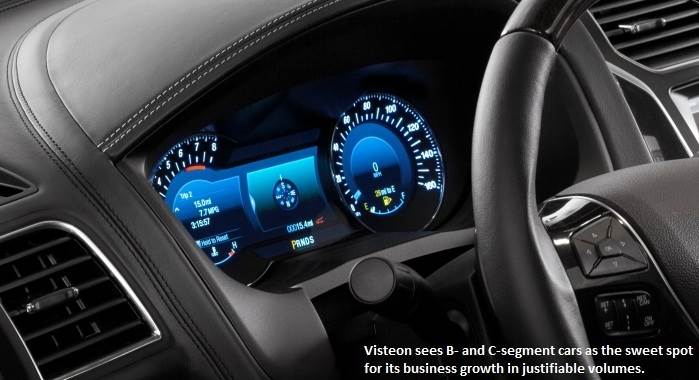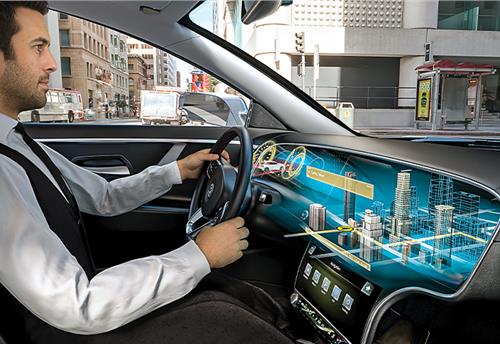Visteon Corporation aims for top spot in car cockpit electronics
On the back of R&D in technology innovation and a singular focus on cockpit electronics, Visteon Corporation aims to emerge as a mega supplier to OEMs in India as well as globally.
Visteon Corporation, the Michigan-based Tier 1 supplier of cockpit electronics to passenger car OEMs globally, had a good year ending on December 31, 2015.
Company documents say that it recorded sales of US$ 3,245 million (Rs 20,498 crore) during 2015, which also represented an increase of US$ 659 million (Rs 4,162 crore) when compared with the year ended December 31, 2014. This growth in 2015 is attributed to electronics acquisition, higher production volumes, and new businesses.
Visteon Corp’s annual report states that its backlog, defined as cumulative remaining life of program booked sales, is close to US$ 15.2 billion as of December 31, 2015. While this is over four times its last year’s total sales, it also hints at Visteon’s strong order book sales that will result from the products to be launched in the future. Interestingly, the company’s electronics segment backlog stood at US$ 14.1 billion on December 31, 2014, which marks a healthy annual growth of 8 percent.
The technology and innovation-driven company has been increasingly investing in its R&D capabilities. Company data reflects that while it spent US$ 148 million in R&D in 2013, it invested US$ 257 million and US$ 294 million in 2014 and 2015 respectively.
While the statistics give a strong sense of R&D and new product development- led growth, president and CEO, Sachin Lawande, who is based at its headquarters in Detriot and was in Pune, India, recently, spoke to Autocar Professional about a clear roadmap to his company’s future.
Fast-paced change in technology
Explaining why Visteon, which was a multi-business Tier 1 supplier until a few years ago, converged into a company with a singular focus on cockpit electronics business, Lawande spoke about the fast-paced changes that the automotive industry is witnessing.
“The automotive industry around the world is over 100 years old. It essentially has not changed much as the technology evolution has been very slow. If you analyse the introduction of a new technology over the last 50 years, it usually takes 15 years to be introduced until it hits about 90 percent of the new vehicles produced, and another 15 years to be present in the 90 percent of the field vehicles. So it takes 30 years for a technology to be introduced and universally used,” he said.

“However, the pace of innovation is speeding up tremendously and against the 15-year period earlier, it is now anywhere between five to six years in two cycles. The case of adoption in the field vehicles is also speeding up because of multiple pressures from three areas. These pressure areas are – competition, consumer pull and regulatory legislations.”
“Visteon used to manufacture everything from interiors, door panels, seating, air-conditioning, to electronics. But with technologies in electronics changing so fast, it was not possible for us as a company to do everything and yet stay on the top of technology. So we shared all our non-core assets and now we are fully focussed on electronics. We now have six product lines – instrument cluster, centre information display – which often is a separate device from the infotainment box, infotainment, telematics and head-up display. These six product lines cover virtually everything that modern cars need in the cockpit. We are one of only two suppliers who have all six products. In every product category, we compete with a different set of competitors.”
Cutting-edge electronics
The increasing role of electronics in automotive is a globally understood phenomenon. According to Lawande, currently on an average, almost 30 percent of the total cost of making a car goes into electronics. This is expected to touch 50 percent in the next 5-10 years.
“Now, we are experiencing an average sales price increase in five out of the six products. We are seeing this increase not because of the pricing pressure but because there is more content that is going in. There is richer display, more capabilities, more software, more CPUs, more memory and that is what is driving the increase in the selling price. However, this sales price increase is a cost to the OEM, which they are not able to pass on to the consumers,” he stated.
With a motive to become a mega-supplier of its preferred six product lines, Visteon, which also has been under tremendous pressure to figure out superior ways to solve this issue (of rising costs), has finally found its answers in SmartCore.

Elaborating in depth on the genesis of its SmartCore platform, Lawande elucidated, “What has happened is that underlying silicon capabilities have grown to a point where we can actually integrate some of the six products. So instead of having a separate electronics box somewhere in the car that does each one of these functions, we can integrate them and reduce the costs. This is the SmartCore platform and we are the leaders in this space. However, it is certain that there will be more competition that will come in because this industry is too big for just us to be able to offer something like that. Additionally, this is more of semi-conductor capabilities as they have gone towards the multi-core approach.”
“To put it simply, we have more CPUs on a single chip and that’s how the multi-core era has come up. It is no longer effective to make a single core processor. None of the six products on their own need a 3GH processor of four cores, which is what have today from the industry. Three years from now, we will get an eight-core product and so on. None of the six products that we make individually need that much capacity. This means we can consolidate. This is an inevitable consequence of what the industry has done on a broader scale,” he added.
Indian OEMs embrace technology
Visteon was the first company to recognise the modularity of the multi-core technology and has now readied products based on its SmartCore platform. However, what surprises this top official is the willingness and urgency with which the Indian OEMs want to embrace the advanced electronics solutions under SmartCore.
“We were the first to recognise it, we have a solution for it and called it SmartCore. With a German OEM, we will launch the first integrated cluster and infotainment system (soon).
This has really caught the imagination of Indian OEMs like I had never imagined. It sounds all nice to integrate and it does result in cost savings but there is a price to pay. There is a lot of virtualisation that has to happen and this complicates an already complicated situation that much more. The perception was that more mature OEMs like the German OEMs would be the first customers. Yes, they were. But the Indians weren’t far behind,” he said.
“What surprised me is also that they have shown willingness to go with this sooner than what I had earlier anticipated. Somebody told me that India has been leapfrogging normal evolutionary sequences all the time.”
Gunning to be no. 1 worldwide
Lawande has a firm plan to transform Visteon Corporation as the undisputed leader in the cockpit electronics business globally. His singular focus on technology and innovation is also driving the new product development towards more cost effective solutions.
Speaking his mind in this context, he said: “We want to be known as the number one technology leader globally. Today, we are not at that position but we clearly are on the path to achieve technology leadership. We believe that this (cockpit electronics) is the fastest growing (and evolving) segment within automotive. General auto sales are growing at 3 percent (worldwide), and electronics within that is growing at 7 percent or even faster. To achieve what we plan to, we will do so on the back of the technology leadership, a tight focus on customer requirements, and a cost-effective mindset. This means we also have to be the leader in costs.”

The openness of Indian OEMs to take up advanced solutions in their upcoming projects is the reason why Lawande believes that his company must have the same capabilities in India as it has elsewhere.
“Because India is leading the adoption of new technologies much more than anyone had earlier imagined, we need to have the same capabilities here as we have in Germany and the US. We now, no more, make that assumption that we will start there and five years later come to India. So having the ability to project the (product development) capabilities globally at the same time is another area important for us,” he clarified.
Speed matters
The top boss also has a clear approach of managing his people internally. While he drives speed at work, he does not believe in layers of hierarchy and unwarranted delays.
“What I push my team constantly on is to operate with speed. So a delayer and decentralised approach is another key aspect that we are following. I believe that if we focus on getting the right people on board with us, establish some good processes and invest in the right tools then we can get there. And deep down I am very confident that we will achieve this. We ended 2015 on a very good note. From a balance sheet point of view, we are the best company in the industry right now (in its league),” he commented.
However, availability of the right talent is the biggest challenge, according to him. “One factor that worries me is the availability of the right talent. We have resources, market presence, brand recognition, great manufacturing capabilities, and a good set of product portfolio. What we actually need is the right people who can take it from here and grow,” he remarked.
The NYSE-listed company acquired the Bangalore-based AllGo Embedded Systems in January 2016. This company was operating in embedded multimedia systems solutions and was associated with a number of OEMs in its value chain. Acquiring AllGo has not only boosted Visteon’s presence in India but has also added greater scale and depth in its infotainment software capabilities.
“It’s a young company started by IIT and IISC alumni. They have been doing a great job. I think we need more of those to bolster our technology capabilities,” said Lawande, who is open for similar valuable acquisitions for Visteon.
Make in India
Appreciating the Make-In-India drive, he said, “India is very important for us as is the Make-In-India initiative. We have a factory in Chennai and I am also looking at whether India can be a base of manufacturing (for export markets). I believe it can be. However, there is one issue that we are working upon, which is the existing supplier base in India for other products such as plastics and basic components like PCBs. This is not rocket science. If we get these things sorted, then India can be as well one of the global manufacturing locations for us.”

He estimates the Indian passenger car market, which currently stands at three million units a year, should expand to 7-8 million units in the next five years. “At that point in time, it will become a really meaningful market for us,” he said.
He sees B- and C-segment cars as the sweet spot for his company to grow its business in justifiable volumes. In that context, he added, “Today, it is mostly composed of the A-segment, which is highly price sensitive. However, I expect that once the market starts to grow beyond five million units, more vehicles in the B-segment and C-segment will start coming in volumes. That’s our sweet spot.
When that space will touch volumes of say two million units (per annum), it will become a very interesting market for us. This is why we consider that investing in India in important.”
“As we go forward here in India, I request you to look at us from the lens of technology leadership. The message I am putting out is about technology leadership, focus on electronics and software, and leveraging India as a base for not only the Indian market but for the rest of the world,” he signed off.
RELATED ARTICLES
BRANDED CONTENT: Spearheading the EV revolution in India
Jio-bp is a joint venture between Reliance Industries and BP PLC where both entities have married international expertis...
Qualcomm devises cost-effective ADAS chip for India
The American technology giant is enabling connectivity in modern cars and aims to tap into the price-conscious Indian ma...
Renault-Nissan Alliance rebooted
The Franco-Japanese alliance is all set to unveil an ambitious SUV line-up amidst fresh investments of Rs 5,300 crore in...





 By Amit Panday
By Amit Panday
 14 May 2016
14 May 2016
 11846 Views
11846 Views









